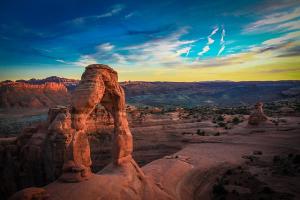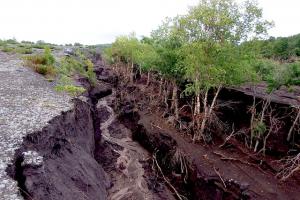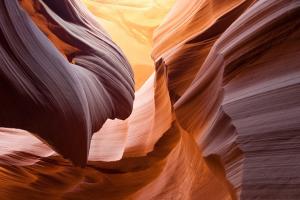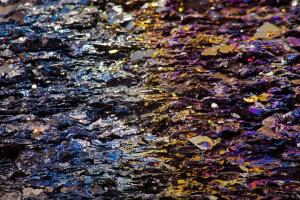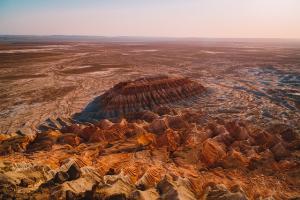Weathering - Definition and Types of Weathering
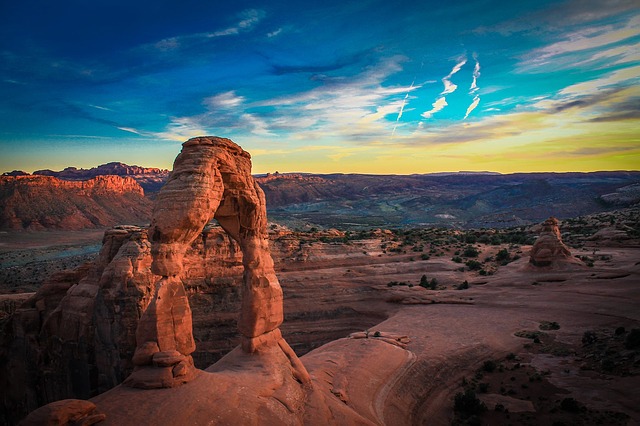
Weathering Definition
It is a natural process of breaking down of rocks, and minerals as well as artificial materials due to its prolonged exposure to the environment. These particles when moved away by gravity, water, ice, wind etc is then known as erosion. In short, when a particle is loosened by a chemical or physical process, but does not move, it is called Weathering. When the particle moves, it is called Erosion. It is a general term and applied to the combine action of all processes causing rocks disintegration physically and decomposition chemically.
Or
It is the process of weakening rock and producing a rock waste or soil cover. Weathering occurs when rocks and minerals comes in contact with the atmosphere, organic life and suicidal water. Essential feature of weathering is that it affects rocks in-situ (in place) and no transportation of material is involved.
Also Read: ![]() Physical Weathering |
Physical Weathering | ![]() Chemical Weathering |
Chemical Weathering | ![]() Rock Faults
Rock Faults
Factors affecting Weathering of rocks are:
- A part of rainfall always snips into the soil on the covered rocks and looses the rock particle by dissolving it.
- Frost action also takes place in the for-spaces of rocks and causes disintegration and splitting of rocks into fragments.
- Chemical reactions are also taking place in rocks internally and causing rock-loosening.
- Slow geological process of construction and destruction is going on the surface of earth for millions of years because earth is old enough and has been completely leveled by weathering and erosion. Factors affecting rock weathering.
Rock weathering is greatly affected by the following parameters.
Types of Weathering
Depending upon the mechanism and causes, weathering can be divided into three broad categories
- Physical Weathering
- Chemical Weathering
- Mechanical Weathering
1. Physical weathering:
In the mechanical disintegration and breaking of the rocks to form particles of smaller size. In physical weathering, the composition of the weathered products remains unchanged. Physical Weathering also known as Mechanical Weathering may occur due to the following reasons:
- High Speed Winds
- Thermal Stress
- Freezing and Thawing
- Pressure Releases
- Hydraulic Actions
- Salt-Crystals Growth
- Organisms
1. High Speed Winds
High Speed winds causes the erosion of surface material
2. Thermal Stress
Thermal stresses are caused by repeated heating and cooling. In deserts the temperature at day time is more causing expansion of bodies while at night the temperature decreases causing contraction eventually leading to breaking of rocks. Heating and cooling of rock masses occur due to daily changes in temperature. Heating of rocks causes expansion and cooling cause contraction of rocks. This repeated heating and cooling helps to develop cracks in rocks and the rock will be disintegrated.
3. Freezing and Thawing
The moisture or water penetrated into cracks when freezes, it expands causing stresses and breaking of rock. Freezing of water in the cracks of rocks tends to disintegrate them because volume of water increases 1-11 times of its actual volume. It exerts a great pressure on the wall having cracks. By this process, angular fragments of rocks are broken off from the main body of the rock, causing physical weathering.
4. Pressure Releases
When some of the material is removed from the surface, the load is reduced and the underlying body expands up causing cracking.
5. Hydraulic Actions
Water from power full waves when strike against the rock causes erosion.
6. Salt-Crystals Growth
When saline solutions seep into cracks and joints in the rocks and evaporate it leaves salt crystals behind. These salt crystals expand as they are heated up thus exerting pressure on the confining rock. In Physical Weathering the broken down particles have same properties as the parent material.
7. Organisms
Plants and insects like earthworms, ants, termites and snakes play an important role in physical weathering because they convert rock into soil to get their food. Plants also grow in joints and cracks of the rocks and push them further apart. Similarly, man also breaks rocks by making roads, constructing dams and reservoirs by drawing tunnels and mines etc.
2. Chemical Weathering:
It is the type of weathering in which the rock minerals are attacked by water, oxygen, or by alkaline or acid materials dissolved in the water. Chemical structure of the rock minerals is altered and Clay minerals are formed in this way. Chemical Weathering may occur due to the following processes and reactions
- Dissolution and Carbonation
- Hydration
- Hydrolysis
- Oxidation
In Chemical Weathering the broken particles have different composition from the parent material and change into different substances
1) Dissolution and Carbonation
- In unpolluted environments, the rainfall pH is around 5.6.
- Acid rain occurs when gases such as sulfur dioxide and nitrogen oxides are present in the atmosphere.
- These oxides react with the rain water to produce stronger acids and lower the pH to 4.5 or even 3.0 causing solution weathering to the rocks on which it falls.
- When rain combines with carbon dioxide or an organic acid it forms a weak carbonic acid which reacts with calcium carbonate (Rock) and forms calcium bicarbonate.
- The process speeds up with a decrease in temperature because colder water holds more dissolved carbon dioxide gas
2) Hydration
In this process rock minerals absorb water and expand, creating stress which causes the disintegration of rocks.
Iron Oxide + Water ---> Iron Hydroxide (Increased Volume)
Anhydrite + Water ---> Gypsum (Increased Volume)
Anhydrite is Unhydrated Calcium Sulphate.
Gypsum is Hydrated Calcium Sulphate
3) Hydrolysis
In this process a chemical reaction takes place between the minerals (Silicates and Carbonates) in the rock and Hydrogen (H+) in rain water.
4) Oxidation
In this process oxygen combine with water and minerals in the rock such as iron, calcium and magnesium to form their oxides. When iron reacts with oxygen, reddish-brown iron oxide is formed. The iron-oxide crust crumbles easily and weakens the rock. This process is commonly known as Rusting
Iron + Oxygen ---> Iron Oxide (Crumbles)
3. Mechanical Weathering
It is the breakdown of the rock by physical or mechanical forces.
Frost wedging and heaving
water enters cracks and expands on freezing, pressure splits rock. alternate freezing and thawing of water in fractures and cracks promotes the disintegration of rocks (water expands about 9% upon freezing)
Exfoliation
rock layers peel like layers of an onion Due to pressure release on igneous rocks (formed in Earth’s crust)
Thermal expansion
repeated heating and cooling of rocks will induce stress and breakage - daily cycle of temperature change weakens rock
Organic activity
physical breakdown and/or transport of material by plants and animals, e.g. plant roots growing in cracks, burrowing animals
Minerals in the parent rock are unchanged
Result is a primary rock mineral, which is the constituent of most sands & gravels
Weathering of rock is a complex process and depends on many factors including:
- Climate – wind, rain, frost & temperature
- Topography (e.g. waterlogged valleys are subjected to deeper weathering than plateaus)
- Rock structure (e.g. presence of faults, joints etc dictate rock fracturing due to freeze-thaw cycles)
- Rock types (e.g. dominance of various minerals dictate resilience to weathering)
Looking at climate
- Mechanical weathering (due to freeze-thaw & heat-cool cycles) obviously depends on climate
- Chemical weathering is also strongly climate dependent as this form of weathering dominates in regions of relatively high humidity and rainfall



